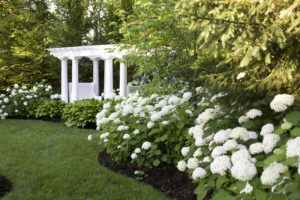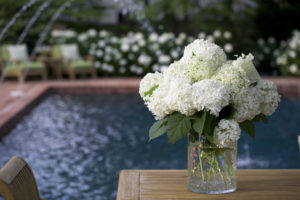
Today I’m sharing a simple pleasure of mine, one that I look forward to each June: the blooming of my hundreds of White Annabelle Hydrangeas. Carefully planted, each year I add even more. If you have a flower you love so much, why not enjoy as many as possible? This stunning cloud-like pouf brings me great joy, and even better – an amazing centerpiece to enjoy inside my home. Interested in planting some hydrangeas yourself? I’m sharing some of my tips and tricks.
- There are so many variations of hydrangeas, so be sure when you’re planting them that you understand which type you have and what they will look like when they finally bloom. Some hydrangeas (Annabelles included) don’t actually have a scent. So, if you’re looking for a pleasant perfumery of a backyard, you might want to check for other types like an Oak Leaf or a Fragrant White.
- The acidity of your soil can determine the flower color. Strange, right? But, true! “For true blue flowers, the hydrangeas need to be grown in acidic soil (pH 5.5 and lower). For pink flowers, the plants need neutral to alkaline soils (pH 6.5 and higher). For purple blooms (or a mix of blue and pink flowers on the same plant), the pH of the soil must be 5.5 and pH 6.5.” (Source: bhg.com). But if you are a ‘true white’ lover like I am, stick with the Annabelle – they are always white no matter what your soil.
- Start small with your plans. Each year, you’ll learn something new as you continue to grow your flower garden, learning what they like or don’t like for your specific environment. Maybe you’ll continue planting the same variation, or maybe you’ll adopt some variety!
- Arrange and share your blooms. Hydrangeas make for such a lovely housewarming or hostess gift, especially if you’ve grown them yourself. Trim your hydrangeas to varying lengths and include some leaves for color. Notice some wilting? “If hydrangea blooms start to prematurely wilt you can totally submerge them in a “bath” of water for about 45 minutes. Then recut and place the stems into boiling water and then back into a vase of fresh water. They should revive in a couple of hours and live another day or two.” (source: stonegableblog.com)

- Water and sun, of course! Hydrangeas love partial sun, and just like their name suggests, you’ll want to be sure they’re happily watered. The soil should remain moist, but not overly soaked.
